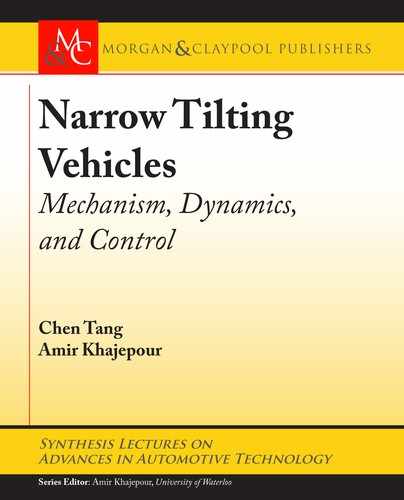3.5. CONCLUSIONS 27
3.4.3 APPLICATION IN SUSPENSION MECHANISM DESIGN
Based on the kinematic (Section 3.4.1) and dynamic (Section 3.4.2) analysis of NTV suspen-
sions, optimizations of the mechanism by considering its impact on NTV behavior could be
applied to enhance vehicle roll stability even further and reduce the tilting effort.
For a design example with trailing-arm suspension, since magnitudes of wheel longitudi-
nal movements .x
1
; x
2
/ should be less than the nominal wheelbase l
0
, signs of the nominator
and denominator terms of the LTR index in Eq. (3.26) are determined as [24]:
(
sign
..
x
1
C x
2
/=
2 C l
0
/
D sign
.
l
0
/
> 0
sign
.
.
x
1
x
2
/=
2 C p
/
D sign
.
p
/
D sign.a
y
/:
(3.27)
By observing the general rollover index from Eq. (3.26), a necessary condition for x
1
and x
2
to improve the vehicle roll stability by minimizing the magnitude of LTR index is
(
x
1
C x
2
0
sign.a
y
/
.
x
1
x
2
/
0:
(3.28)
Since lateral acceleration a
y
points toward the inner bend of the curve, the two front
wheels can be denoted as inner and outer wheels, respectively. According to vehicle cornering
directions, the necessary condition in Eq. (3.28) can be simplified as
(
x
in
C x
out
0
x
in
x
out
0
,
(
x
out
0
j
x
in
j
x
out
;
(3.29)
where x
i n
and x
out
denote the wheel longitudinal movement on inner- and outer-side, re-
spectively.
is necessary condition is also visualized in Figure 3.5. In order to realize the preferred
wheel longitudinal movement and improve the rollover stability during tilting, the outer-wheel is
expected to move backward, while the inner-wheel is free to move in both forward and backward
directions, with the magnitude bounded by that of the outer wheel. Such conditions could then
be formulated in a suspension design optimization process as detailed in [24].
3.5 CONCLUSIONS
is chapter studies the vehicle dynamics of tilting vehicles. Starting with vehicle modeling in
lateral and roll planes, a re-configurable structure which handles various NTV configurations is
proposed, and an integrated NTV model is suggested. LTR as a roll stability measure is derived
for control implementations in the next chapter. e impact of suspension mechanism on NTV
dynamics is discussed in detail, which suggests a proper mechanism design could be utilized to
enhance NTV stability even further.
..................Content has been hidden....................
You can't read the all page of ebook, please click here login for view all page.

